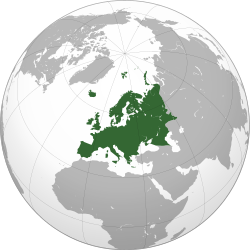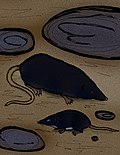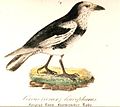It has been suggested that List of Corsica, Sardinia, and Sicily animals extinct in the Holocene be merged into this article. ( Discuss ) Proposed since September 2025. |

This is a list of European species extinct in the Holocene that covers extinctions from the Holocene epoch, a geologic epoch that began about 11,650 years before present (about 9700 BCE) [A] and continues to the present day. [1]
Contents
- Mammals (class Mammalia)
- Elephant-like mammals (order Proboscidea)
- Lagomorphs (order Lagomorpha)
- Rodents (order Rodentia)
- True insectivores (order Eulipotyphla)
- Carnivorans (order Carnivora)
- Odd-toed ungulates (order Perissodactyla)
- Even-toed ungulates (order Artiodactyla)
- Birds (class Aves)
- Rails and cranes (order Gruiformes)
- Shorebirds (order Charadriiformes)
- Pelicans, herons, and ibises (order Pelecaniformes)
- Hawks and relatives (order Accipitriformes)
- Owls (order Strigiformes)
- Perching birds (order Passeriformes)
- Reptiles (class Reptilia)
- Squamates (order Squamata)
- Ray-finned fish (class Actinopterygii)
- Sturgeons and paddlefishes (order Acipenseriformes)
- Minnows and allies (order Cypriniformes)
- Salmon, trout and relatives (order Salmoniformes)
- Lionfishes and sculpins (order Scorpaeniformes)
- Cartilaginous fish (class Chondrichthyes)
- Shovelnose rays and allies (order Rhinopristiformes)
- Lampreys and relatives (class Hyperoartia)
- Lampreys (order Petromyzontiformes)
- Insects (class Insecta)
- Praying mantises (order Mantodea)
- Bark lice, book lice and parasitic lice (order Psocodea)
- Beetles (order Coleoptera)
- Butterflies and moths (order Lepidoptera)
- Caddisflies (order Trichoptera)
- Flies and mosquitos (order Diptera)
- Slugs and snails (class Gastropoda)
- Order Littorinimorpha
- Order Stylommatophora
- Sea anemones, corals, and zoanthids (class Hexacorallia)
- Sea anemones (order Actiniaria)
- Plants (kingdom Plantae)
- Order Asterales
- Order Ericales
- Order Poales
- See also
- Notes
- References
- External links
This list includes the European continent and its surrounding islands. All large islands in the Mediterranean Sea are included except for Cyprus, which is in the List of Asian animals extinct in the Holocene. The recently extinct animals of the Macaronesian islands in the North Atlantic are listed separately. The three Caucasian republics of Georgia, Azerbaijan, and Armenia are included, even though their territory may fall partially or fully in Asia depending on the definition of Europe considered.
Overseas territories, departments, and constituent countries of European countries are not included here; they are found on the lists pertaining to their respective regions. For example, French Polynesia is grouped with Oceania, Martinique is grouped with the West Indies, and Réunion is grouped with Madagascar and the Indian Ocean islands, despite all of them being politically part of France.
Many extinction dates are unknown due to a lack of relevant information.


























































